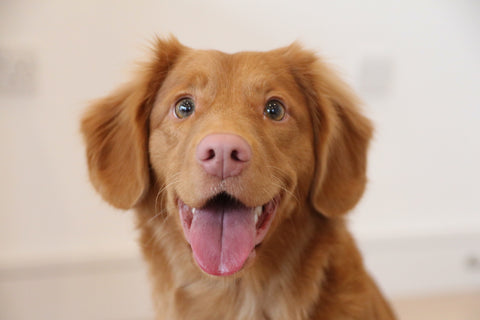
As humans, our minds are constantly full of thoughts. Therefore, it’s natural to wonder what our dogs are thinking about each day. Do dogs have thoughts? Do dogs think in barks? And what do dogs think about all day long? There is so much curiosity into the minds of our beloved pets, and so much to uncover about what goes on inside their heads.
Here we answer all your dog thinking-related questions and look into the psychology and neuroscience that wires our dog's brains. The better you can understand your dog’s thought process, the more you can understand their communication and give them a fulfilling life.
Do Dogs Think?
First thing’s first, do dogs have thoughts at all? While there is still much to uncover about the canine mind, various studies have looked at dog brains to try and understand how their cognition works. And while the thought process isn’t entirely understood, one thing is clear: dogs do think!
At least, dogs think in the most basic sense of the word. They might not have comprehensive thought processes like humans, but they have the ability to make decisions, recognize behaviors, and understand commands. For example, your dog will likely be able to sit on instruction and will be able to choose between two bowls of food. This all requires conscious thought and awareness. The neurons in their brains fire signals and create thought processes that power their actions.
Dogs are also able to tell when you’re feeling happy or sad and can tell whether a stranger is friendly or aggressive. This shows dogs are also capable of feeling and understanding emotions. Studies have found that dogs can feel six basic feelings: optimism, anxiety, happiness, fear, depression, and jealousy. In research, a fully-grown adult dog is often described as having the same emotional capacity as a 2.5-year-old child.
How Do Dogs Think?
We know from research that the canine mind can think, but how do dogs think? According to research, dog thinking is likely very different from human thinking. As humans, the size of our brains alone is very different – the human brain is around the size of two clenched fists, whereas dogs' brains are the size of a lemon.
Within this brain mass, we humans have intricate neural pathways that help structure thoughts and ideas. We also have multiple specialized brain regions, with functions such as problem-solving, memory, language, and judgment all controlled in the frontal lobe. Comparatively, dogs have far fewer neural pathways and specialized brain structures. Their frontal lobe accounts for 20% less of their total brain than ours, and therefore they have much simpler thought processes.
As such, while we think logically and draw thoughts based on memory and language, dogs make cognitive decisions based on the senses they are feeling. Dogs mostly rely on their exceptional sense of smell for this, which is why dogs sniff everything wherever they go. They then learn to form associations with these smells to help formulate their future thoughts. For example, your dog will recognize you from your smell alone, even if you completely altered your physical appearance.
The process through which dogs learn voice commands is comparable to their smell-based learning. They form an association with a word such as “sit” with the act of sitting down and getting a treat. This is known as positive reinforcement training, and dogs can amazingly understand 2,000 human words through this learning process. However, dogs are unlikely to think in human words and won’t process their own thoughts in human language.
In what language do dogs think? Do dogs think in barks? Unfortunately, we do not yet know the answer to this question. While we can study the different neural pathways and brain regions, it is impossible to tell which language they’re hearing in their minds. With that said, many scientists theorize that dogs think in smell, sound, and images rather than words or barks.
What Do Dogs Think About?
With simplified brains and neural networks, understanding what a dog thinks about is actually very straightforward. They aren’t sitting there replaying memories from the past or thinking about the future. Dogs live in the present and think about whatever they are experiencing within that moment. This makes sense seeing as they base their thoughts on their senses.
For example, if you have just given your dog a bowl of food, they’ll be thinking about how good it smells, how delicious it tastes, and how hungry they are. If you take your dog on a walk, they’ll be thinking about all the smells they pass and whether they have smelt them before. If you’ve been at work all day, your dog will sense your smell slowly fading and could feel anxious or depressed. In turn, this could manifest as destructive behavior or whining.
You can also easily tell what dogs think about by looking at their body language. Although they cannot verbally communicate how they are feeling, they can express their thoughts through their actions. A happy dog will wag its tail, or a dog that wants cuddles might rest its head on your lap. A dog that wants to play might bring you a toy, or a dog that needs to pee might bark at the door.
One of the best qualities about dogs is that they never feel angry. Dogs don’t process this emotion in their brain, and any aggression towards you or destructive behavior comes from a place of fear or anxiety. Besides, their ability to think in the present means dogs will never hold a grudge against you or plot revenge. Dogs are simple, loving creatures! Many people think that a staring dog is angry, but this is actually a sign of trust and affection.
Final Thoughts
“What do dogs think about?” is a question we might never know the answer to completely. However, by paying close attention to your dog’s body language you can learn to understand their emotions. You can then assess their current environment to try and work out what has caused this feeling. After all, dogs think with their senses.
You can then use your imagination to fill in the blanks. You know your dog better than anyone else, so if anyone can get to the bottom of how they are feeling, it’s you!
